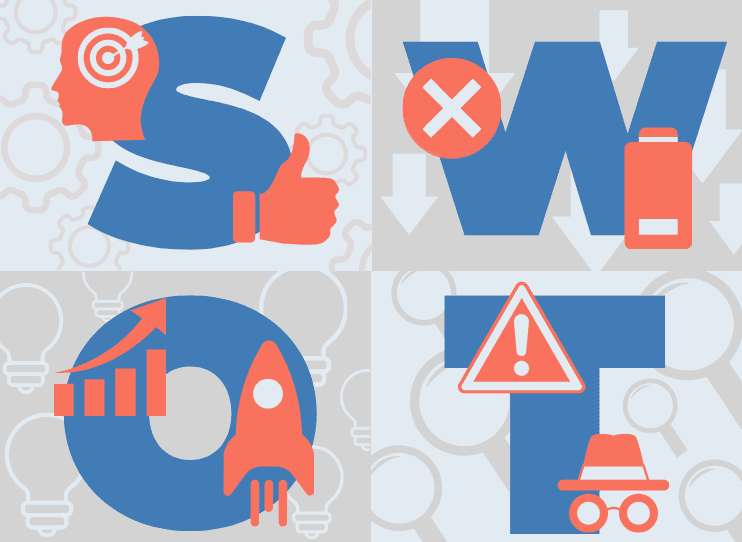What is a SWOT Analysis? Unlock Your Marketing Potential
As a marketer, you always look for ways to improve marketing strategies and maximize your efforts. A SWOT analysis is a powerful tool to help you do just that. But what exactly is a SWOT analysis, and why is it crucial for your marketing efforts?
A SWOT analysis is a simple but effective strategic planning technique for analyzing your business and identifying its strengths, weaknesses, opportunities, and threats. It's a way to take a step back and objectively assess your marketing strategies, looking at internal and external factors that may impact your success. By conducting a SWOT analysis, you can better understand what's working well, where you need to improve, what new opportunities you can pursue, and how to prioritize them.
Conducting a SWOT analysis is a helpful way to pinpoint the areas of weakness in your marketing strategies. For example, you may find that your website needs to be optimized for search engines or that your email marketing campaigns need to generate the desired results.
Key Components of a SWOT Analysis
To effectively carry out this analysis, it is crucial to understand the four key components that make up a SWOT.
-
Strengths: Internal factors that give an organization a competitive advantage. Examples could include a strong brand reputation, a skilled workforce, or advanced technology:
-
Skilled workforce: A company with employees with a wide range of skills and expertise can help the organization innovate and stay ahead of competitors.
-
Strong brand reputation: A well-established brand known for high-quality products or services can attract loyal customers and help the company maintain market share.
-
-
Weaknesses: Internal factors that put an organization at a disadvantage compared to its competitors. Examples could include high team member turnover, limited financial resources, or outdated technology:
-
Limited financial resources: An organization that lacks financial resources to invest in research and development or marketing could struggle to compete with its rivals.
-
Inadequate training: A workforce that lacks proper training and development opportunities may struggle to keep up with industry trends, leading to a decline in productivity and innovation.
-
-
Opportunities: External factors that can positively affect an organization's growth and profitability. Examples could include a growing market, changes in regulations or consumer trends, or the availability of new technologies:
-
Growing demand: A company that operates in an industry with a growing demand for its products or services can benefit from increased sales and revenue.
-
New market entry: An organization that enters a new market can reach new customers and expand its revenue stream.
-
-
Threats: External factors that can negatively affect an organization's growth and profitability. Examples could include increased competition, economic downturns, or changes in regulations.
-
Competitive pressure: An organization facing intense competition from established players or new entrants may struggle to maintain its market share and profitability.
-
Changing consumer preferences: A company that fails to adapt to changing consumer preferences may lose its market share and customer loyalty.
-
By examining these four components in detail, businesses can better understand their current market position and make more informed decisions about future approaches.
Identifying Growth Opportunities with SWOT
In addition to your strengths and weaknesses, a SWOT analysis can help you identify growth opportunities and new marketing initiatives.
For example, you may find a new trend in your industry that you can capitalize on or a new social media platform that's particularly popular with your target audience. The business world is ever-changing, and staying up to date with the latest trends and developments in your industry is essential. By conducting a SWOT analysis, you can identify new opportunities to capitalize on, such as emerging trends or the popularity of new social media platforms.
For instance, if you're in the fashion industry, you may discover a growing demand for sustainable fashion, and you can adjust your marketing and production strategies accordingly.
Alternatively, suppose your target audience is increasingly active on social media. In that case, you can focus on building a strong presence on that platform to reach and engage with your audience more effectively.
Determine your audience and dig into those topics. Through this analysis, you can help tailor your marketing strategies to their specific needs. Learning how to utilize social media effectively and understanding your audience can strengthen your brand presence and increase your chances of success. Staying on top of trends and developments can give your business a competitive edge and help you achieve your goals.
Mitigating Potential Threats to Your Marketing Efforts through SWOT Analysis
One of the key benefits of a SWOT analysis is its ability to identify potential threats to your marketing efforts. By analyzing the external factors that may impact your business, such as market changes, new competitors, or changing customer preferences, you can anticipate potential threats and develop strategies to mitigate them.
For instance, if a new competitor enters your market, you can adjust your marketing strategies to differentiate your brand and remain competitive. Similarly, if you anticipate changes in customer needs, you can adapt your product offerings or marketing messages to meet their evolving preferences.
Staying proactive and anticipating potential threats can also help you explore new opportunities. By remaining agile and adaptable, you can pivot your inbound marketing strategy to capitalize on emerging trends and stay ahead of the competition.
Additionally, by continually monitoring the external factors that impact your business, you can ensure that your marketing efforts align with your target audience's needs and preferences. This can help you build a strong brand reputation and maintain your position as a leader in your industry.
Staying proactive and anticipating potential threats can also help you take advantage of new opportunities as they arise.
Finding Your Full Potential with the SWOT Analysis Toolkit
By identifying your strengths, weaknesses, opportunities, and threats, you can develop a clear understanding of your business and your market. Check out SWOT Analysis Toolkit for a free download. This understanding will allow you to make strategic decisions to help you reach your target audience more effectively, differentiate your brand, and stay ahead of the competition.
Whether a small startup or a large corporation, a SWOT analysis can provide valuable insights to help you achieve your marketing goals and grow your business. Aspiration Marketing can assist you in conducting a comprehensive SWOT analysis for your business and provide tailored recommendations to help you achieve your marketing goals.
With our expertise and support, you can unlock your marketing efforts' full potential and succeed in your industry.
This content is also available in:
- German: Was ist eine SWOT-Analyse? Erschließen Sie Ihr Marketing-Potenzial
- Spanish: ¿Qué es un análisis SWOT? Libere su potencial de marketing
- French: Qu'est-ce qu'une analyse SWOT ? Libérez votre potentiel marketing
- Italian: Cos'è l'analisi SWOT? Liberate il vostro potenziale di marketing
- Chinese: 什么是 SWOT 分析?释放您的营销潜能











Leave a Comment